Densification of London Suburbs: Housing Needs and Sustainability
VerifiedAdded on 2020/01/06
|24
|8048
|229
Report
AI Summary
This report examines the densification of London's outer suburbs as a strategy to address the capital's housing needs. It investigates the concept of sustainable densification, the housing crisis in London, and various densification policies. The study assesses the effectiveness of densification in satisfying housing demands, considering factors such as sustainability, cost, and the capacity of suburban areas and garden cities. The research methodology includes a multi-methodological approach with background research, case studies, and interviews. The report also addresses the significance of the study, structure of the dissertation, and research questions, providing insights into the implications of densification on infrastructure, transportation, and the environment, with a focus on balancing development with the character of suburban areas.
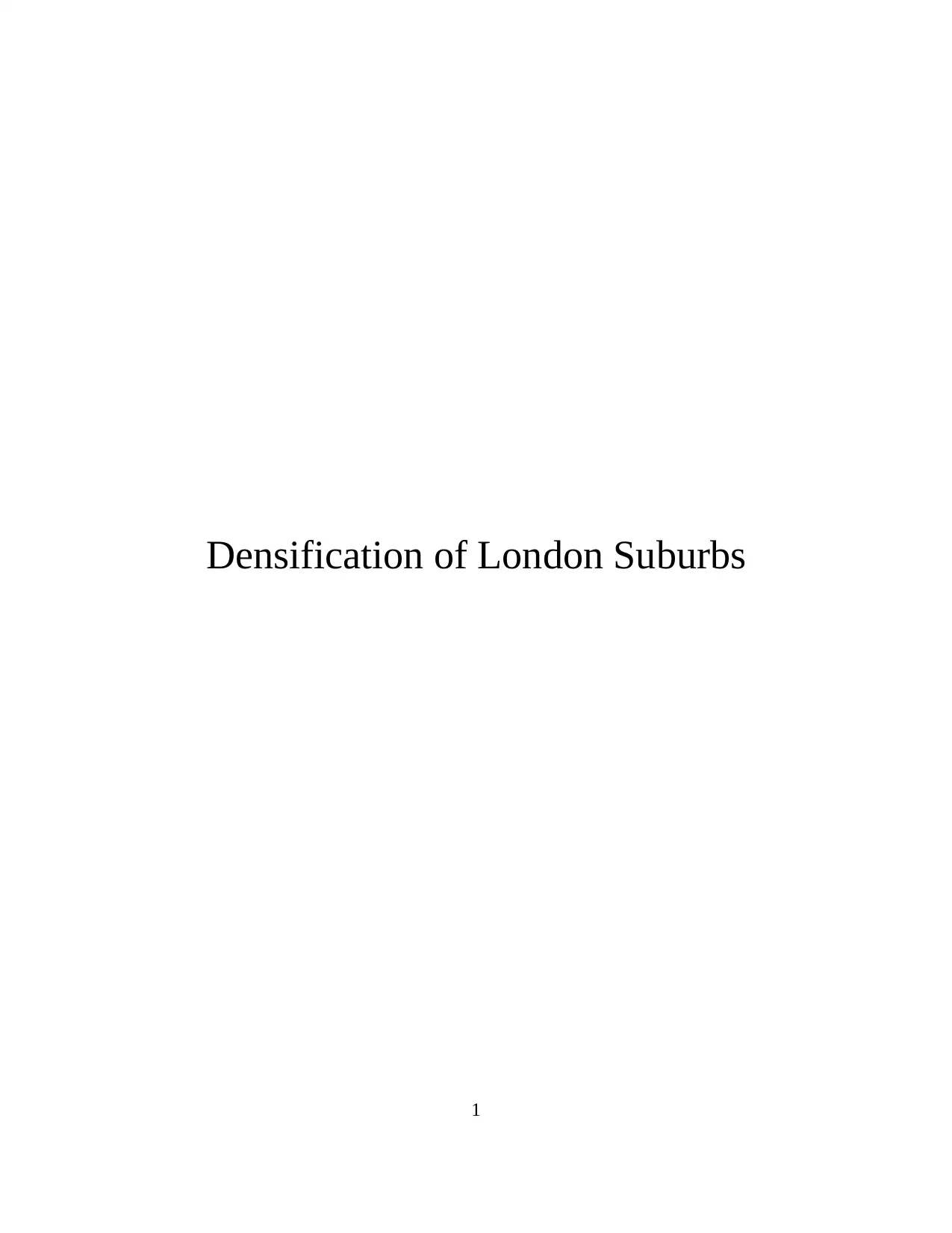
Densification of London Suburbs
1
1
Paraphrase This Document
Need a fresh take? Get an instant paraphrase of this document with our AI Paraphraser
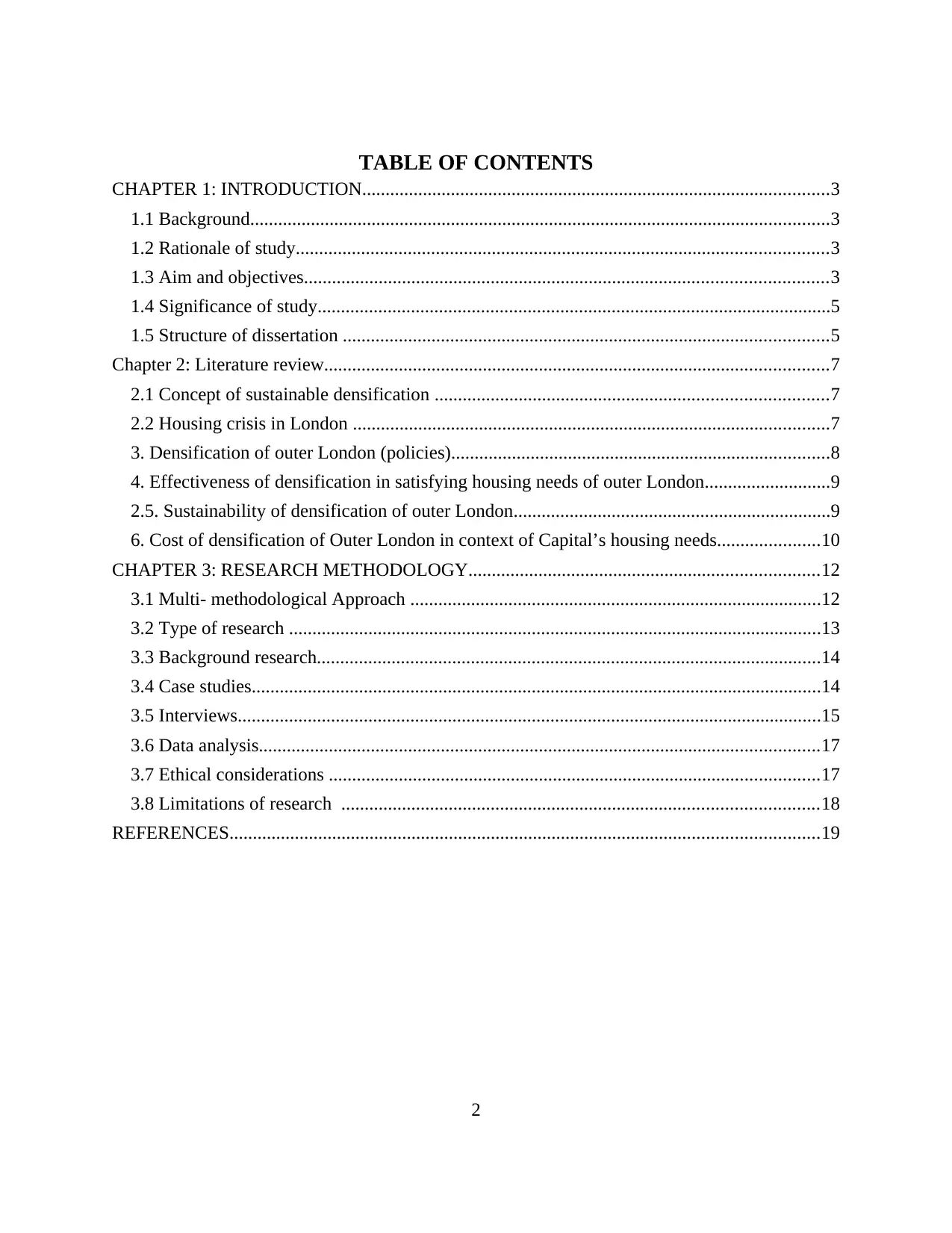
TABLE OF CONTENTS
CHAPTER 1: INTRODUCTION....................................................................................................3
1.1 Background............................................................................................................................3
1.2 Rationale of study..................................................................................................................3
1.3 Aim and objectives................................................................................................................3
1.4 Significance of study..............................................................................................................5
1.5 Structure of dissertation ........................................................................................................5
Chapter 2: Literature review............................................................................................................7
2.1 Concept of sustainable densification ....................................................................................7
2.2 Housing crisis in London ......................................................................................................7
3. Densification of outer London (policies).................................................................................8
4. Effectiveness of densification in satisfying housing needs of outer London...........................9
2.5. Sustainability of densification of outer London....................................................................9
6. Cost of densification of Outer London in context of Capital’s housing needs......................10
CHAPTER 3: RESEARCH METHODOLOGY...........................................................................12
3.1 Multi- methodological Approach ........................................................................................12
3.2 Type of research ..................................................................................................................13
3.3 Background research............................................................................................................14
3.4 Case studies..........................................................................................................................14
3.5 Interviews.............................................................................................................................15
3.6 Data analysis........................................................................................................................17
3.7 Ethical considerations .........................................................................................................17
3.8 Limitations of research ......................................................................................................18
REFERENCES..............................................................................................................................19
2
CHAPTER 1: INTRODUCTION....................................................................................................3
1.1 Background............................................................................................................................3
1.2 Rationale of study..................................................................................................................3
1.3 Aim and objectives................................................................................................................3
1.4 Significance of study..............................................................................................................5
1.5 Structure of dissertation ........................................................................................................5
Chapter 2: Literature review............................................................................................................7
2.1 Concept of sustainable densification ....................................................................................7
2.2 Housing crisis in London ......................................................................................................7
3. Densification of outer London (policies).................................................................................8
4. Effectiveness of densification in satisfying housing needs of outer London...........................9
2.5. Sustainability of densification of outer London....................................................................9
6. Cost of densification of Outer London in context of Capital’s housing needs......................10
CHAPTER 3: RESEARCH METHODOLOGY...........................................................................12
3.1 Multi- methodological Approach ........................................................................................12
3.2 Type of research ..................................................................................................................13
3.3 Background research............................................................................................................14
3.4 Case studies..........................................................................................................................14
3.5 Interviews.............................................................................................................................15
3.6 Data analysis........................................................................................................................17
3.7 Ethical considerations .........................................................................................................17
3.8 Limitations of research ......................................................................................................18
REFERENCES..............................................................................................................................19
2
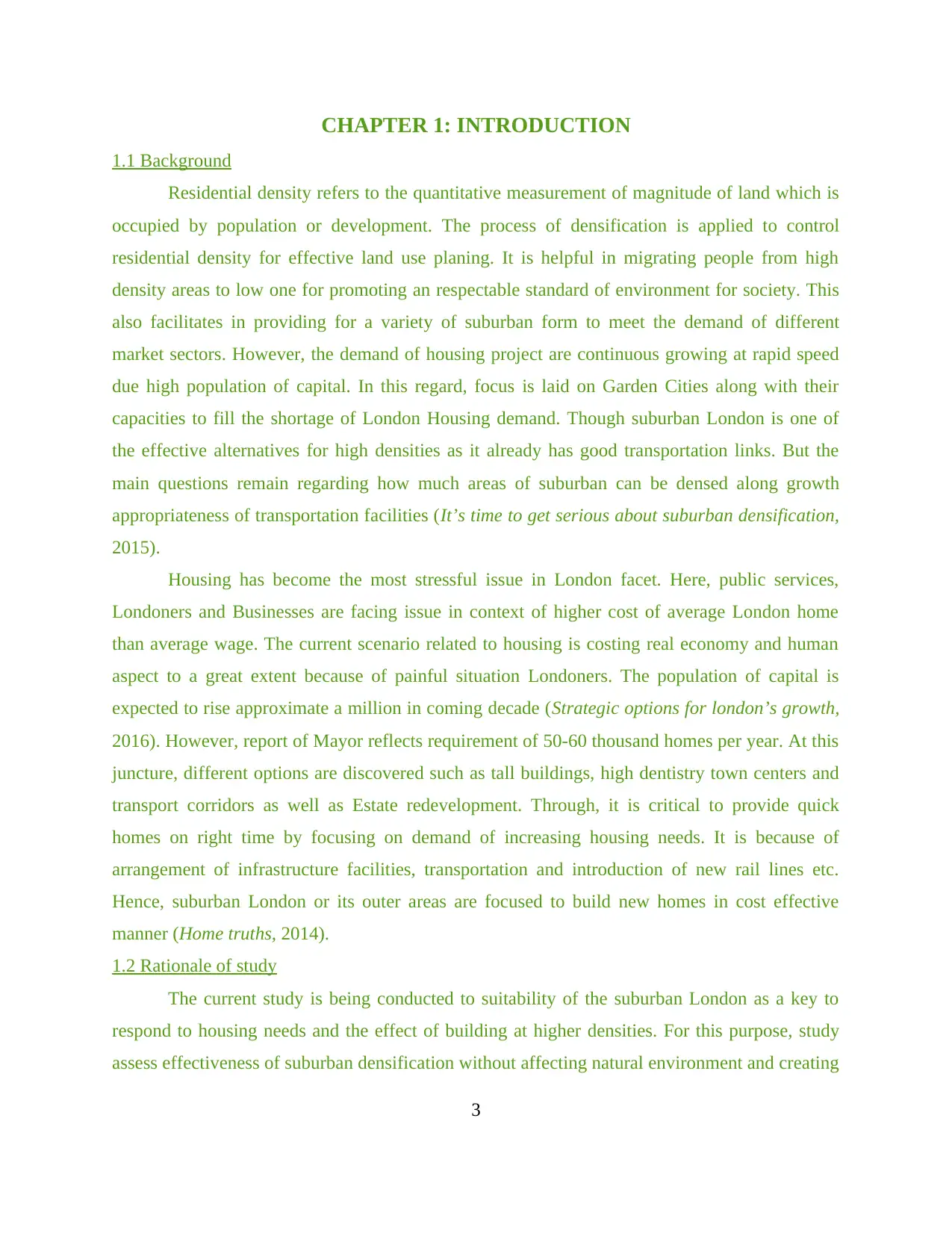
CHAPTER 1: INTRODUCTION
1.1 Background
Residential density refers to the quantitative measurement of magnitude of land which is
occupied by population or development. The process of densification is applied to control
residential density for effective land use planing. It is helpful in migrating people from high
density areas to low one for promoting an respectable standard of environment for society. This
also facilitates in providing for a variety of suburban form to meet the demand of different
market sectors. However, the demand of housing project are continuous growing at rapid speed
due high population of capital. In this regard, focus is laid on Garden Cities along with their
capacities to fill the shortage of London Housing demand. Though suburban London is one of
the effective alternatives for high densities as it already has good transportation links. But the
main questions remain regarding how much areas of suburban can be densed along growth
appropriateness of transportation facilities (It’s time to get serious about suburban densification,
2015).
Housing has become the most stressful issue in London facet. Here, public services,
Londoners and Businesses are facing issue in context of higher cost of average London home
than average wage. The current scenario related to housing is costing real economy and human
aspect to a great extent because of painful situation Londoners. The population of capital is
expected to rise approximate a million in coming decade (Strategic options for london’s growth,
2016). However, report of Mayor reflects requirement of 50-60 thousand homes per year. At this
juncture, different options are discovered such as tall buildings, high dentistry town centers and
transport corridors as well as Estate redevelopment. Through, it is critical to provide quick
homes on right time by focusing on demand of increasing housing needs. It is because of
arrangement of infrastructure facilities, transportation and introduction of new rail lines etc.
Hence, suburban London or its outer areas are focused to build new homes in cost effective
manner (Home truths, 2014).
1.2 Rationale of study
The current study is being conducted to suitability of the suburban London as a key to
respond to housing needs and the effect of building at higher densities. For this purpose, study
assess effectiveness of suburban densification without affecting natural environment and creating
3
1.1 Background
Residential density refers to the quantitative measurement of magnitude of land which is
occupied by population or development. The process of densification is applied to control
residential density for effective land use planing. It is helpful in migrating people from high
density areas to low one for promoting an respectable standard of environment for society. This
also facilitates in providing for a variety of suburban form to meet the demand of different
market sectors. However, the demand of housing project are continuous growing at rapid speed
due high population of capital. In this regard, focus is laid on Garden Cities along with their
capacities to fill the shortage of London Housing demand. Though suburban London is one of
the effective alternatives for high densities as it already has good transportation links. But the
main questions remain regarding how much areas of suburban can be densed along growth
appropriateness of transportation facilities (It’s time to get serious about suburban densification,
2015).
Housing has become the most stressful issue in London facet. Here, public services,
Londoners and Businesses are facing issue in context of higher cost of average London home
than average wage. The current scenario related to housing is costing real economy and human
aspect to a great extent because of painful situation Londoners. The population of capital is
expected to rise approximate a million in coming decade (Strategic options for london’s growth,
2016). However, report of Mayor reflects requirement of 50-60 thousand homes per year. At this
juncture, different options are discovered such as tall buildings, high dentistry town centers and
transport corridors as well as Estate redevelopment. Through, it is critical to provide quick
homes on right time by focusing on demand of increasing housing needs. It is because of
arrangement of infrastructure facilities, transportation and introduction of new rail lines etc.
Hence, suburban London or its outer areas are focused to build new homes in cost effective
manner (Home truths, 2014).
1.2 Rationale of study
The current study is being conducted to suitability of the suburban London as a key to
respond to housing needs and the effect of building at higher densities. For this purpose, study
assess effectiveness of suburban densification without affecting natural environment and creating
3
⊘ This is a preview!⊘
Do you want full access?
Subscribe today to unlock all pages.

Trusted by 1+ million students worldwide
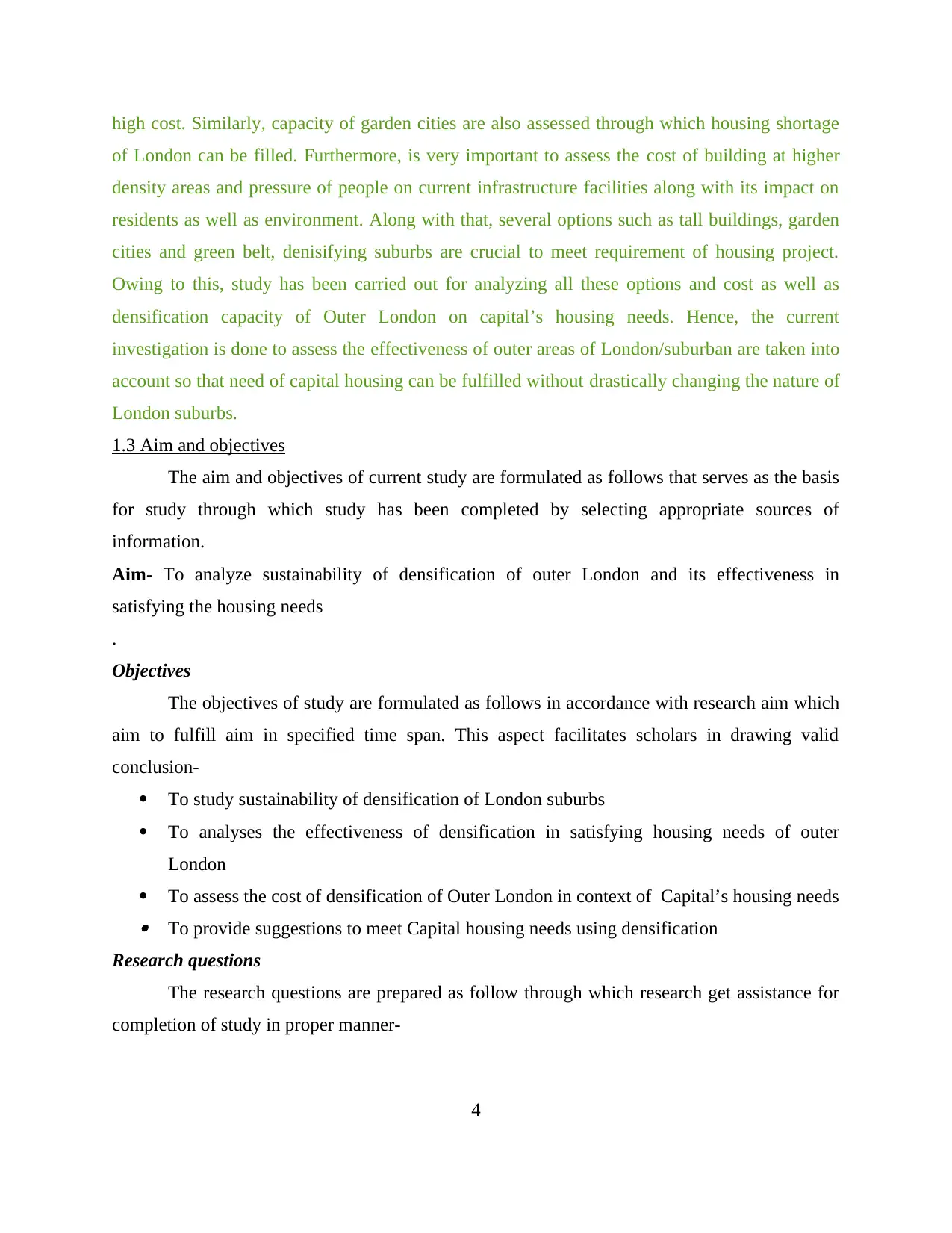
high cost. Similarly, capacity of garden cities are also assessed through which housing shortage
of London can be filled. Furthermore, is very important to assess the cost of building at higher
density areas and pressure of people on current infrastructure facilities along with its impact on
residents as well as environment. Along with that, several options such as tall buildings, garden
cities and green belt, denisifying suburbs are crucial to meet requirement of housing project.
Owing to this, study has been carried out for analyzing all these options and cost as well as
densification capacity of Outer London on capital’s housing needs. Hence, the current
investigation is done to assess the effectiveness of outer areas of London/suburban are taken into
account so that need of capital housing can be fulfilled without drastically changing the nature of
London suburbs.
1.3 Aim and objectives
The aim and objectives of current study are formulated as follows that serves as the basis
for study through which study has been completed by selecting appropriate sources of
information.
Aim- To analyze sustainability of densification of outer London and its effectiveness in
satisfying the housing needs
.
Objectives
The objectives of study are formulated as follows in accordance with research aim which
aim to fulfill aim in specified time span. This aspect facilitates scholars in drawing valid
conclusion-
To study sustainability of densification of London suburbs
To analyses the effectiveness of densification in satisfying housing needs of outer
London
To assess the cost of densification of Outer London in context of Capital’s housing needs To provide suggestions to meet Capital housing needs using densification
Research questions
The research questions are prepared as follow through which research get assistance for
completion of study in proper manner-
4
of London can be filled. Furthermore, is very important to assess the cost of building at higher
density areas and pressure of people on current infrastructure facilities along with its impact on
residents as well as environment. Along with that, several options such as tall buildings, garden
cities and green belt, denisifying suburbs are crucial to meet requirement of housing project.
Owing to this, study has been carried out for analyzing all these options and cost as well as
densification capacity of Outer London on capital’s housing needs. Hence, the current
investigation is done to assess the effectiveness of outer areas of London/suburban are taken into
account so that need of capital housing can be fulfilled without drastically changing the nature of
London suburbs.
1.3 Aim and objectives
The aim and objectives of current study are formulated as follows that serves as the basis
for study through which study has been completed by selecting appropriate sources of
information.
Aim- To analyze sustainability of densification of outer London and its effectiveness in
satisfying the housing needs
.
Objectives
The objectives of study are formulated as follows in accordance with research aim which
aim to fulfill aim in specified time span. This aspect facilitates scholars in drawing valid
conclusion-
To study sustainability of densification of London suburbs
To analyses the effectiveness of densification in satisfying housing needs of outer
London
To assess the cost of densification of Outer London in context of Capital’s housing needs To provide suggestions to meet Capital housing needs using densification
Research questions
The research questions are prepared as follow through which research get assistance for
completion of study in proper manner-
4
Paraphrase This Document
Need a fresh take? Get an instant paraphrase of this document with our AI Paraphraser
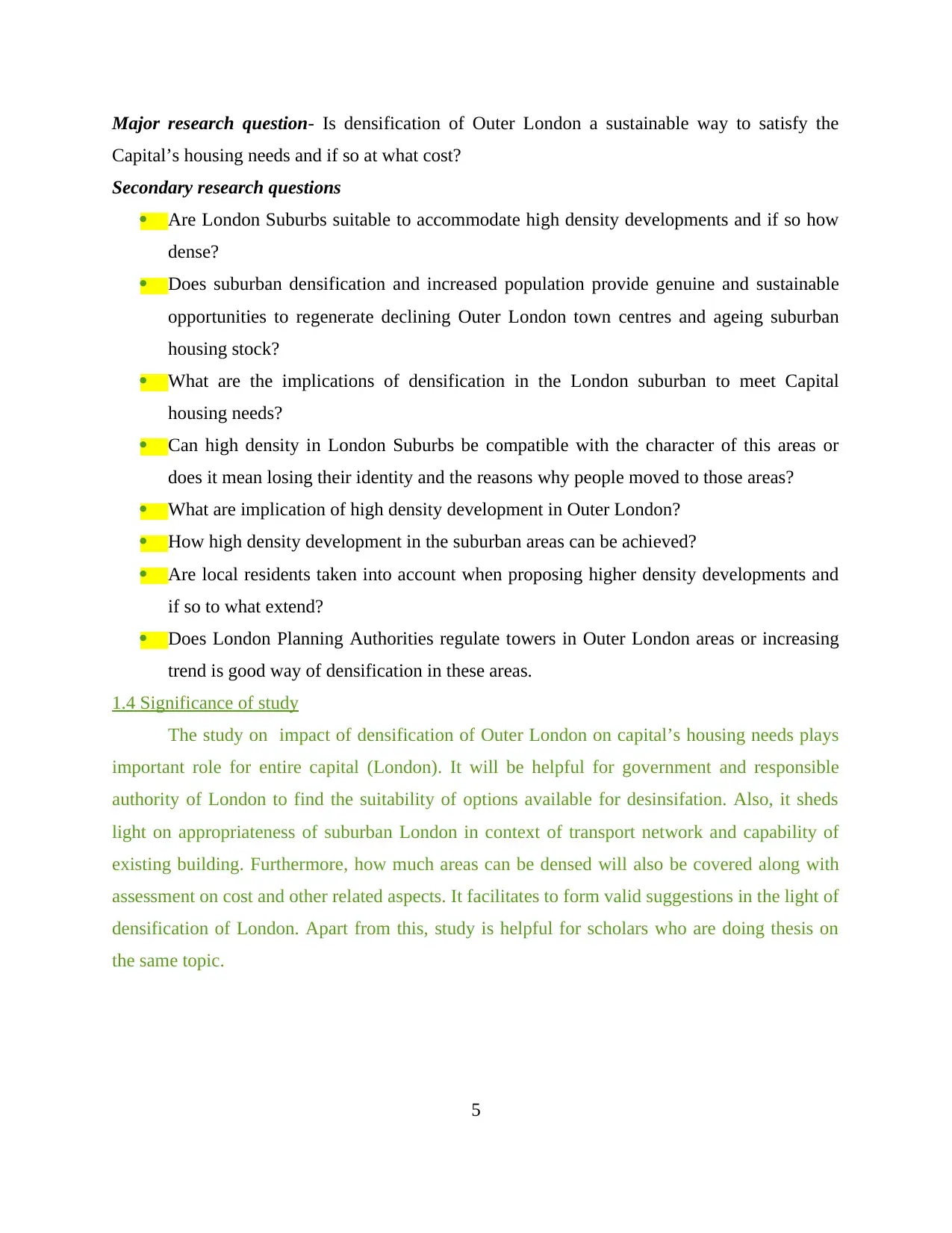
Major research question- Is densification of Outer London a sustainable way to satisfy the
Capital’s housing needs and if so at what cost?
Secondary research questions
Are London Suburbs suitable to accommodate high density developments and if so how
dense?
Does suburban densification and increased population provide genuine and sustainable
opportunities to regenerate declining Outer London town centres and ageing suburban
housing stock?
What are the implications of densification in the London suburban to meet Capital
housing needs?
Can high density in London Suburbs be compatible with the character of this areas or
does it mean losing their identity and the reasons why people moved to those areas?
What are implication of high density development in Outer London?
How high density development in the suburban areas can be achieved?
Are local residents taken into account when proposing higher density developments and
if so to what extend?
Does London Planning Authorities regulate towers in Outer London areas or increasing
trend is good way of densification in these areas.
1.4 Significance of study
The study on impact of densification of Outer London on capital’s housing needs plays
important role for entire capital (London). It will be helpful for government and responsible
authority of London to find the suitability of options available for desinsifation. Also, it sheds
light on appropriateness of suburban London in context of transport network and capability of
existing building. Furthermore, how much areas can be densed will also be covered along with
assessment on cost and other related aspects. It facilitates to form valid suggestions in the light of
densification of London. Apart from this, study is helpful for scholars who are doing thesis on
the same topic.
5
Capital’s housing needs and if so at what cost?
Secondary research questions
Are London Suburbs suitable to accommodate high density developments and if so how
dense?
Does suburban densification and increased population provide genuine and sustainable
opportunities to regenerate declining Outer London town centres and ageing suburban
housing stock?
What are the implications of densification in the London suburban to meet Capital
housing needs?
Can high density in London Suburbs be compatible with the character of this areas or
does it mean losing their identity and the reasons why people moved to those areas?
What are implication of high density development in Outer London?
How high density development in the suburban areas can be achieved?
Are local residents taken into account when proposing higher density developments and
if so to what extend?
Does London Planning Authorities regulate towers in Outer London areas or increasing
trend is good way of densification in these areas.
1.4 Significance of study
The study on impact of densification of Outer London on capital’s housing needs plays
important role for entire capital (London). It will be helpful for government and responsible
authority of London to find the suitability of options available for desinsifation. Also, it sheds
light on appropriateness of suburban London in context of transport network and capability of
existing building. Furthermore, how much areas can be densed will also be covered along with
assessment on cost and other related aspects. It facilitates to form valid suggestions in the light of
densification of London. Apart from this, study is helpful for scholars who are doing thesis on
the same topic.
5
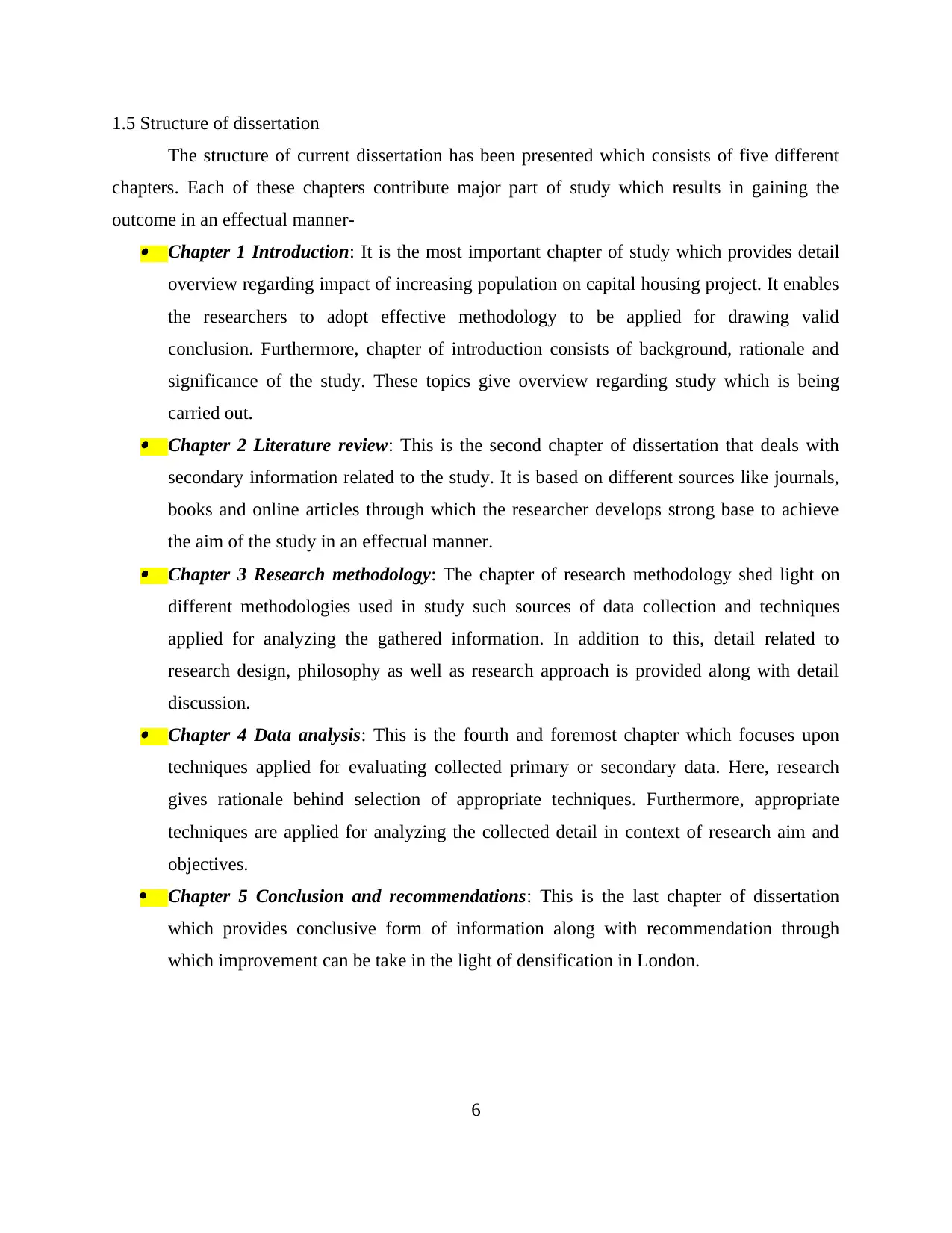
1.5 Structure of dissertation
The structure of current dissertation has been presented which consists of five different
chapters. Each of these chapters contribute major part of study which results in gaining the
outcome in an effectual manner- Chapter 1 Introduction: It is the most important chapter of study which provides detail
overview regarding impact of increasing population on capital housing project. It enables
the researchers to adopt effective methodology to be applied for drawing valid
conclusion. Furthermore, chapter of introduction consists of background, rationale and
significance of the study. These topics give overview regarding study which is being
carried out. Chapter 2 Literature review: This is the second chapter of dissertation that deals with
secondary information related to the study. It is based on different sources like journals,
books and online articles through which the researcher develops strong base to achieve
the aim of the study in an effectual manner. Chapter 3 Research methodology: The chapter of research methodology shed light on
different methodologies used in study such sources of data collection and techniques
applied for analyzing the gathered information. In addition to this, detail related to
research design, philosophy as well as research approach is provided along with detail
discussion. Chapter 4 Data analysis: This is the fourth and foremost chapter which focuses upon
techniques applied for evaluating collected primary or secondary data. Here, research
gives rationale behind selection of appropriate techniques. Furthermore, appropriate
techniques are applied for analyzing the collected detail in context of research aim and
objectives.
Chapter 5 Conclusion and recommendations: This is the last chapter of dissertation
which provides conclusive form of information along with recommendation through
which improvement can be take in the light of densification in London.
6
The structure of current dissertation has been presented which consists of five different
chapters. Each of these chapters contribute major part of study which results in gaining the
outcome in an effectual manner- Chapter 1 Introduction: It is the most important chapter of study which provides detail
overview regarding impact of increasing population on capital housing project. It enables
the researchers to adopt effective methodology to be applied for drawing valid
conclusion. Furthermore, chapter of introduction consists of background, rationale and
significance of the study. These topics give overview regarding study which is being
carried out. Chapter 2 Literature review: This is the second chapter of dissertation that deals with
secondary information related to the study. It is based on different sources like journals,
books and online articles through which the researcher develops strong base to achieve
the aim of the study in an effectual manner. Chapter 3 Research methodology: The chapter of research methodology shed light on
different methodologies used in study such sources of data collection and techniques
applied for analyzing the gathered information. In addition to this, detail related to
research design, philosophy as well as research approach is provided along with detail
discussion. Chapter 4 Data analysis: This is the fourth and foremost chapter which focuses upon
techniques applied for evaluating collected primary or secondary data. Here, research
gives rationale behind selection of appropriate techniques. Furthermore, appropriate
techniques are applied for analyzing the collected detail in context of research aim and
objectives.
Chapter 5 Conclusion and recommendations: This is the last chapter of dissertation
which provides conclusive form of information along with recommendation through
which improvement can be take in the light of densification in London.
6
⊘ This is a preview!⊘
Do you want full access?
Subscribe today to unlock all pages.

Trusted by 1+ million students worldwide
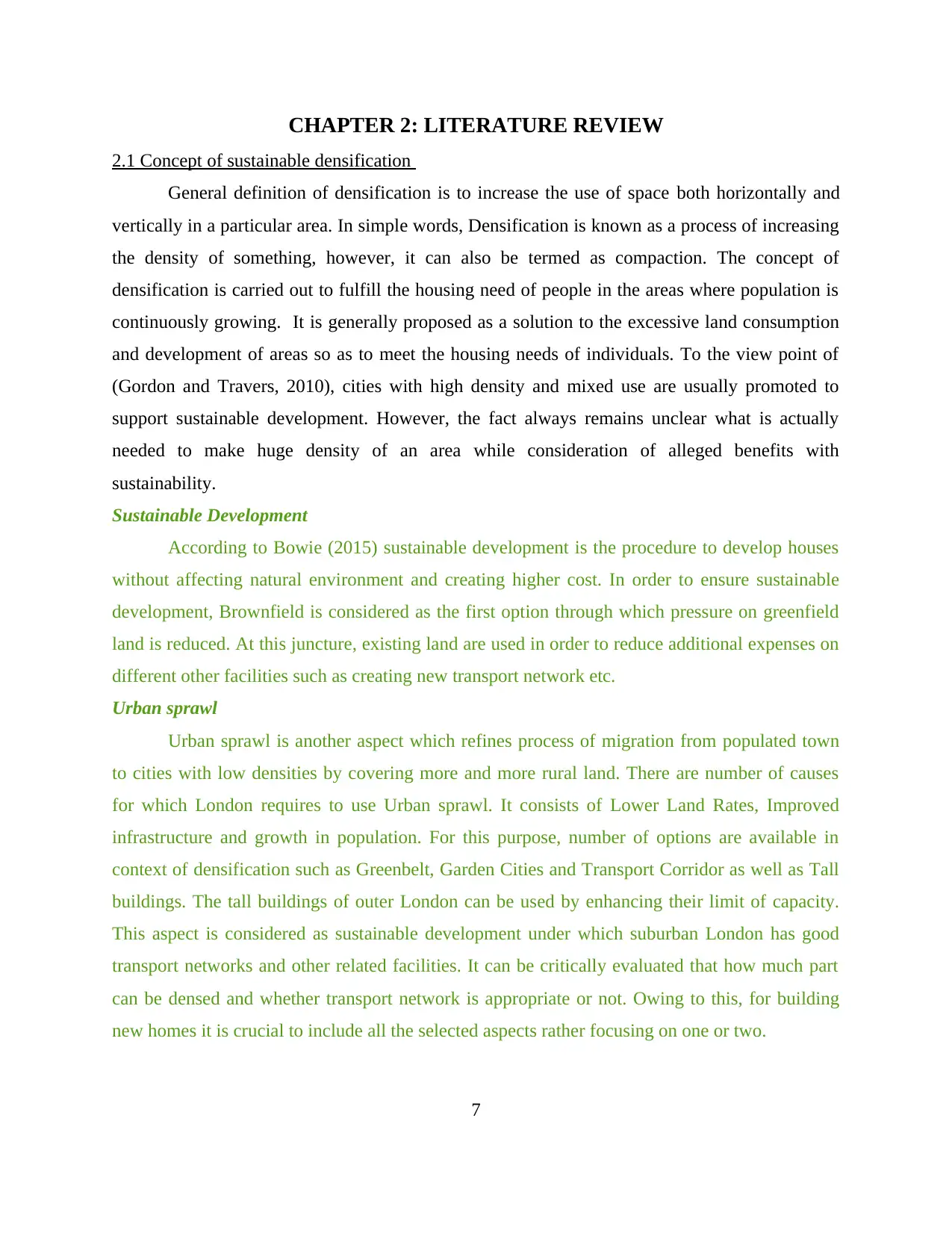
CHAPTER 2: LITERATURE REVIEW
2.1 Concept of sustainable densification
General definition of densification is to increase the use of space both horizontally and
vertically in a particular area. In simple words, Densification is known as a process of increasing
the density of something, however, it can also be termed as compaction. The concept of
densification is carried out to fulfill the housing need of people in the areas where population is
continuously growing. It is generally proposed as a solution to the excessive land consumption
and development of areas so as to meet the housing needs of individuals. To the view point of
(Gordon and Travers, 2010), cities with high density and mixed use are usually promoted to
support sustainable development. However, the fact always remains unclear what is actually
needed to make huge density of an area while consideration of alleged benefits with
sustainability.
Sustainable Development
According to Bowie (2015) sustainable development is the procedure to develop houses
without affecting natural environment and creating higher cost. In order to ensure sustainable
development, Brownfield is considered as the first option through which pressure on greenfield
land is reduced. At this juncture, existing land are used in order to reduce additional expenses on
different other facilities such as creating new transport network etc.
Urban sprawl
Urban sprawl is another aspect which refines process of migration from populated town
to cities with low densities by covering more and more rural land. There are number of causes
for which London requires to use Urban sprawl. It consists of Lower Land Rates, Improved
infrastructure and growth in population. For this purpose, number of options are available in
context of densification such as Greenbelt, Garden Cities and Transport Corridor as well as Tall
buildings. The tall buildings of outer London can be used by enhancing their limit of capacity.
This aspect is considered as sustainable development under which suburban London has good
transport networks and other related facilities. It can be critically evaluated that how much part
can be densed and whether transport network is appropriate or not. Owing to this, for building
new homes it is crucial to include all the selected aspects rather focusing on one or two.
7
2.1 Concept of sustainable densification
General definition of densification is to increase the use of space both horizontally and
vertically in a particular area. In simple words, Densification is known as a process of increasing
the density of something, however, it can also be termed as compaction. The concept of
densification is carried out to fulfill the housing need of people in the areas where population is
continuously growing. It is generally proposed as a solution to the excessive land consumption
and development of areas so as to meet the housing needs of individuals. To the view point of
(Gordon and Travers, 2010), cities with high density and mixed use are usually promoted to
support sustainable development. However, the fact always remains unclear what is actually
needed to make huge density of an area while consideration of alleged benefits with
sustainability.
Sustainable Development
According to Bowie (2015) sustainable development is the procedure to develop houses
without affecting natural environment and creating higher cost. In order to ensure sustainable
development, Brownfield is considered as the first option through which pressure on greenfield
land is reduced. At this juncture, existing land are used in order to reduce additional expenses on
different other facilities such as creating new transport network etc.
Urban sprawl
Urban sprawl is another aspect which refines process of migration from populated town
to cities with low densities by covering more and more rural land. There are number of causes
for which London requires to use Urban sprawl. It consists of Lower Land Rates, Improved
infrastructure and growth in population. For this purpose, number of options are available in
context of densification such as Greenbelt, Garden Cities and Transport Corridor as well as Tall
buildings. The tall buildings of outer London can be used by enhancing their limit of capacity.
This aspect is considered as sustainable development under which suburban London has good
transport networks and other related facilities. It can be critically evaluated that how much part
can be densed and whether transport network is appropriate or not. Owing to this, for building
new homes it is crucial to include all the selected aspects rather focusing on one or two.
7
Paraphrase This Document
Need a fresh take? Get an instant paraphrase of this document with our AI Paraphraser
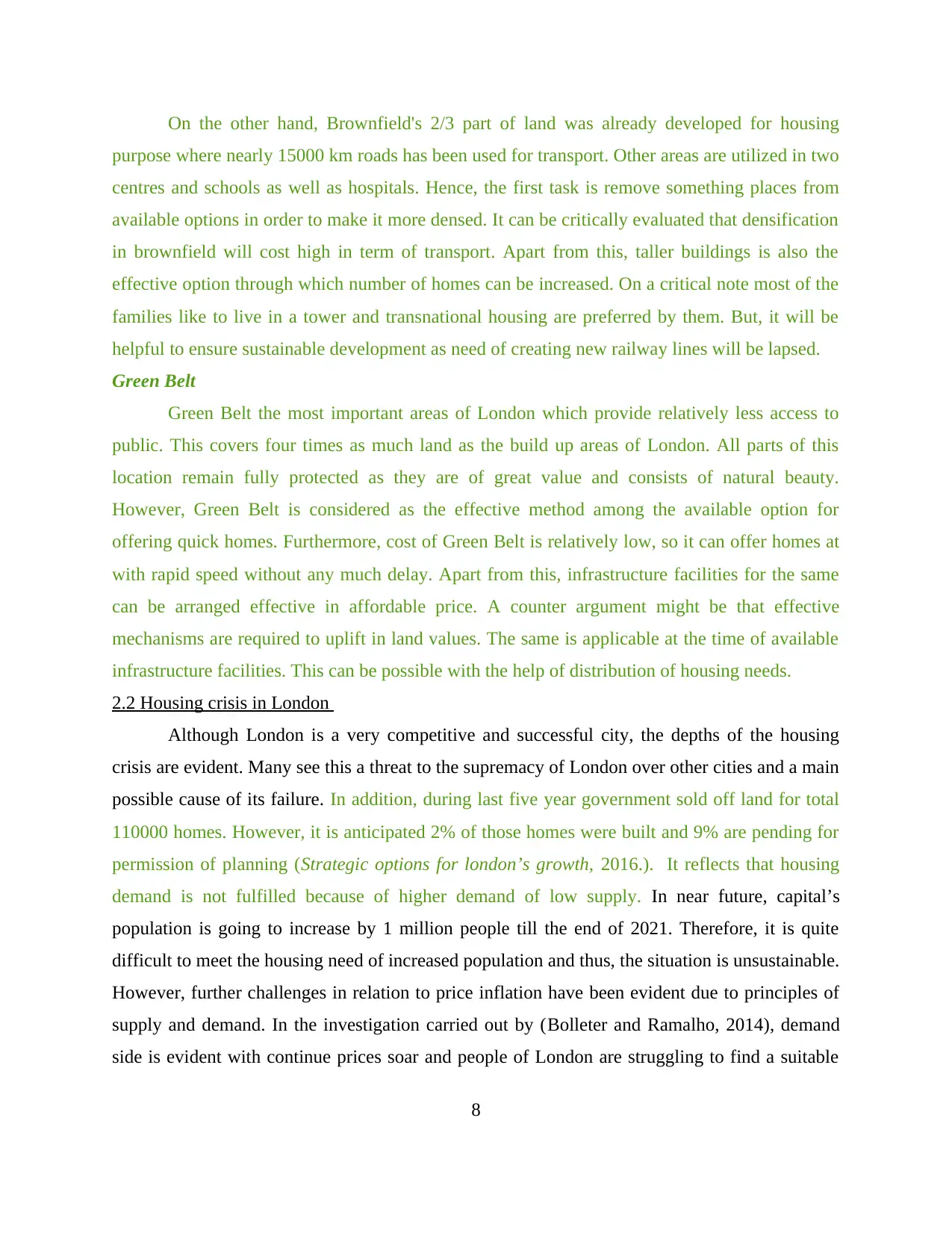
On the other hand, Brownfield's 2/3 part of land was already developed for housing
purpose where nearly 15000 km roads has been used for transport. Other areas are utilized in two
centres and schools as well as hospitals. Hence, the first task is remove something places from
available options in order to make it more densed. It can be critically evaluated that densification
in brownfield will cost high in term of transport. Apart from this, taller buildings is also the
effective option through which number of homes can be increased. On a critical note most of the
families like to live in a tower and transnational housing are preferred by them. But, it will be
helpful to ensure sustainable development as need of creating new railway lines will be lapsed.
Green Belt
Green Belt the most important areas of London which provide relatively less access to
public. This covers four times as much land as the build up areas of London. All parts of this
location remain fully protected as they are of great value and consists of natural beauty.
However, Green Belt is considered as the effective method among the available option for
offering quick homes. Furthermore, cost of Green Belt is relatively low, so it can offer homes at
with rapid speed without any much delay. Apart from this, infrastructure facilities for the same
can be arranged effective in affordable price. A counter argument might be that effective
mechanisms are required to uplift in land values. The same is applicable at the time of available
infrastructure facilities. This can be possible with the help of distribution of housing needs.
2.2 Housing crisis in London
Although London is a very competitive and successful city, the depths of the housing
crisis are evident. Many see this a threat to the supremacy of London over other cities and a main
possible cause of its failure. In addition, during last five year government sold off land for total
110000 homes. However, it is anticipated 2% of those homes were built and 9% are pending for
permission of planning (Strategic options for london’s growth, 2016.). It reflects that housing
demand is not fulfilled because of higher demand of low supply. In near future, capital’s
population is going to increase by 1 million people till the end of 2021. Therefore, it is quite
difficult to meet the housing need of increased population and thus, the situation is unsustainable.
However, further challenges in relation to price inflation have been evident due to principles of
supply and demand. In the investigation carried out by (Bolleter and Ramalho, 2014), demand
side is evident with continue prices soar and people of London are struggling to find a suitable
8
purpose where nearly 15000 km roads has been used for transport. Other areas are utilized in two
centres and schools as well as hospitals. Hence, the first task is remove something places from
available options in order to make it more densed. It can be critically evaluated that densification
in brownfield will cost high in term of transport. Apart from this, taller buildings is also the
effective option through which number of homes can be increased. On a critical note most of the
families like to live in a tower and transnational housing are preferred by them. But, it will be
helpful to ensure sustainable development as need of creating new railway lines will be lapsed.
Green Belt
Green Belt the most important areas of London which provide relatively less access to
public. This covers four times as much land as the build up areas of London. All parts of this
location remain fully protected as they are of great value and consists of natural beauty.
However, Green Belt is considered as the effective method among the available option for
offering quick homes. Furthermore, cost of Green Belt is relatively low, so it can offer homes at
with rapid speed without any much delay. Apart from this, infrastructure facilities for the same
can be arranged effective in affordable price. A counter argument might be that effective
mechanisms are required to uplift in land values. The same is applicable at the time of available
infrastructure facilities. This can be possible with the help of distribution of housing needs.
2.2 Housing crisis in London
Although London is a very competitive and successful city, the depths of the housing
crisis are evident. Many see this a threat to the supremacy of London over other cities and a main
possible cause of its failure. In addition, during last five year government sold off land for total
110000 homes. However, it is anticipated 2% of those homes were built and 9% are pending for
permission of planning (Strategic options for london’s growth, 2016.). It reflects that housing
demand is not fulfilled because of higher demand of low supply. In near future, capital’s
population is going to increase by 1 million people till the end of 2021. Therefore, it is quite
difficult to meet the housing need of increased population and thus, the situation is unsustainable.
However, further challenges in relation to price inflation have been evident due to principles of
supply and demand. In the investigation carried out by (Bolleter and Ramalho, 2014), demand
side is evident with continue prices soar and people of London are struggling to find a suitable
8
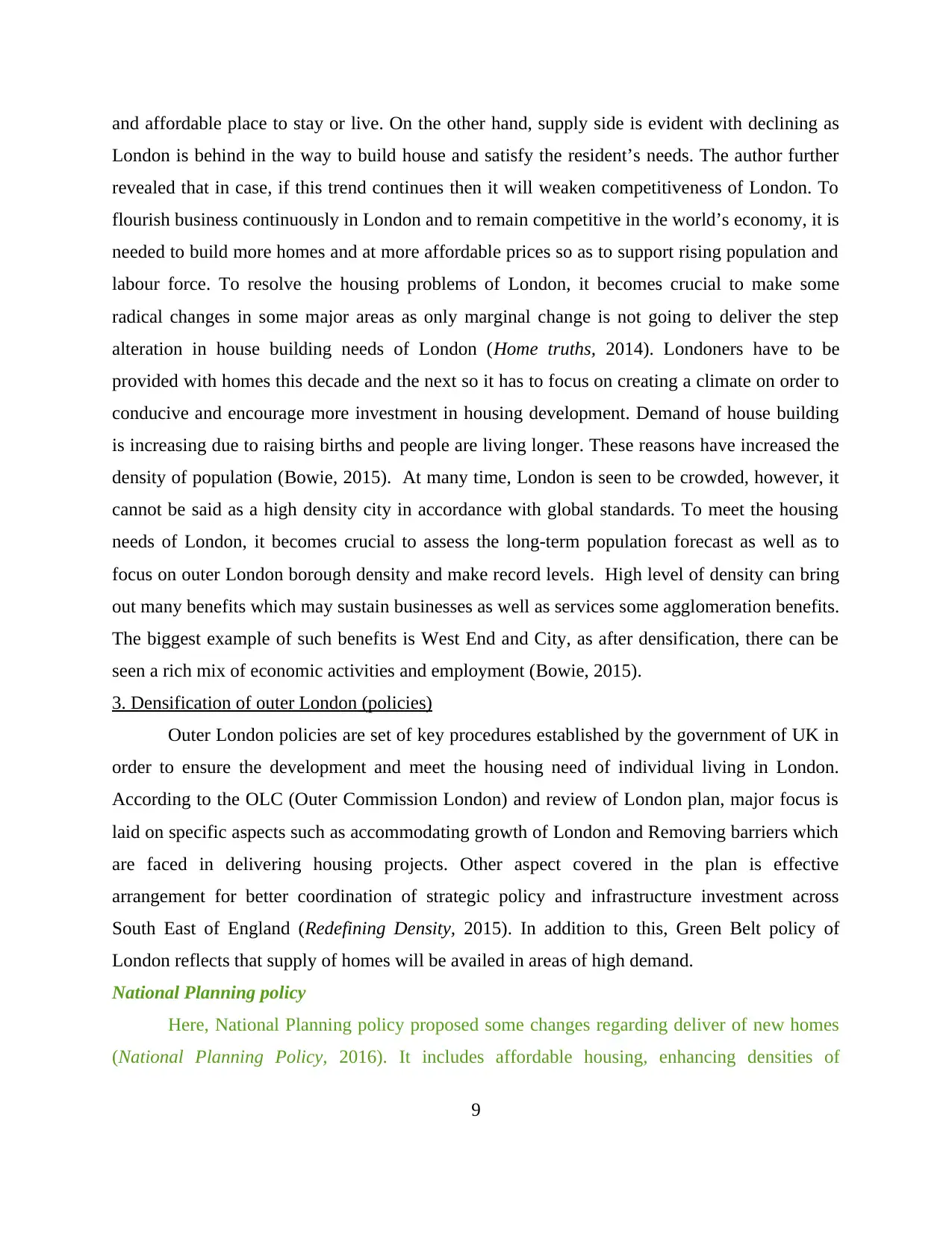
and affordable place to stay or live. On the other hand, supply side is evident with declining as
London is behind in the way to build house and satisfy the resident’s needs. The author further
revealed that in case, if this trend continues then it will weaken competitiveness of London. To
flourish business continuously in London and to remain competitive in the world’s economy, it is
needed to build more homes and at more affordable prices so as to support rising population and
labour force. To resolve the housing problems of London, it becomes crucial to make some
radical changes in some major areas as only marginal change is not going to deliver the step
alteration in house building needs of London (Home truths, 2014). Londoners have to be
provided with homes this decade and the next so it has to focus on creating a climate on order to
conducive and encourage more investment in housing development. Demand of house building
is increasing due to raising births and people are living longer. These reasons have increased the
density of population (Bowie, 2015). At many time, London is seen to be crowded, however, it
cannot be said as a high density city in accordance with global standards. To meet the housing
needs of London, it becomes crucial to assess the long-term population forecast as well as to
focus on outer London borough density and make record levels. High level of density can bring
out many benefits which may sustain businesses as well as services some agglomeration benefits.
The biggest example of such benefits is West End and City, as after densification, there can be
seen a rich mix of economic activities and employment (Bowie, 2015).
3. Densification of outer London (policies)
Outer London policies are set of key procedures established by the government of UK in
order to ensure the development and meet the housing need of individual living in London.
According to the OLC (Outer Commission London) and review of London plan, major focus is
laid on specific aspects such as accommodating growth of London and Removing barriers which
are faced in delivering housing projects. Other aspect covered in the plan is effective
arrangement for better coordination of strategic policy and infrastructure investment across
South East of England (Redefining Density, 2015). In addition to this, Green Belt policy of
London reflects that supply of homes will be availed in areas of high demand.
National Planning policy
Here, National Planning policy proposed some changes regarding deliver of new homes
(National Planning Policy, 2016). It includes affordable housing, enhancing densities of
9
London is behind in the way to build house and satisfy the resident’s needs. The author further
revealed that in case, if this trend continues then it will weaken competitiveness of London. To
flourish business continuously in London and to remain competitive in the world’s economy, it is
needed to build more homes and at more affordable prices so as to support rising population and
labour force. To resolve the housing problems of London, it becomes crucial to make some
radical changes in some major areas as only marginal change is not going to deliver the step
alteration in house building needs of London (Home truths, 2014). Londoners have to be
provided with homes this decade and the next so it has to focus on creating a climate on order to
conducive and encourage more investment in housing development. Demand of house building
is increasing due to raising births and people are living longer. These reasons have increased the
density of population (Bowie, 2015). At many time, London is seen to be crowded, however, it
cannot be said as a high density city in accordance with global standards. To meet the housing
needs of London, it becomes crucial to assess the long-term population forecast as well as to
focus on outer London borough density and make record levels. High level of density can bring
out many benefits which may sustain businesses as well as services some agglomeration benefits.
The biggest example of such benefits is West End and City, as after densification, there can be
seen a rich mix of economic activities and employment (Bowie, 2015).
3. Densification of outer London (policies)
Outer London policies are set of key procedures established by the government of UK in
order to ensure the development and meet the housing need of individual living in London.
According to the OLC (Outer Commission London) and review of London plan, major focus is
laid on specific aspects such as accommodating growth of London and Removing barriers which
are faced in delivering housing projects. Other aspect covered in the plan is effective
arrangement for better coordination of strategic policy and infrastructure investment across
South East of England (Redefining Density, 2015). In addition to this, Green Belt policy of
London reflects that supply of homes will be availed in areas of high demand.
National Planning policy
Here, National Planning policy proposed some changes regarding deliver of new homes
(National Planning Policy, 2016). It includes affordable housing, enhancing densities of
9
⊘ This is a preview!⊘
Do you want full access?
Subscribe today to unlock all pages.

Trusted by 1+ million students worldwide
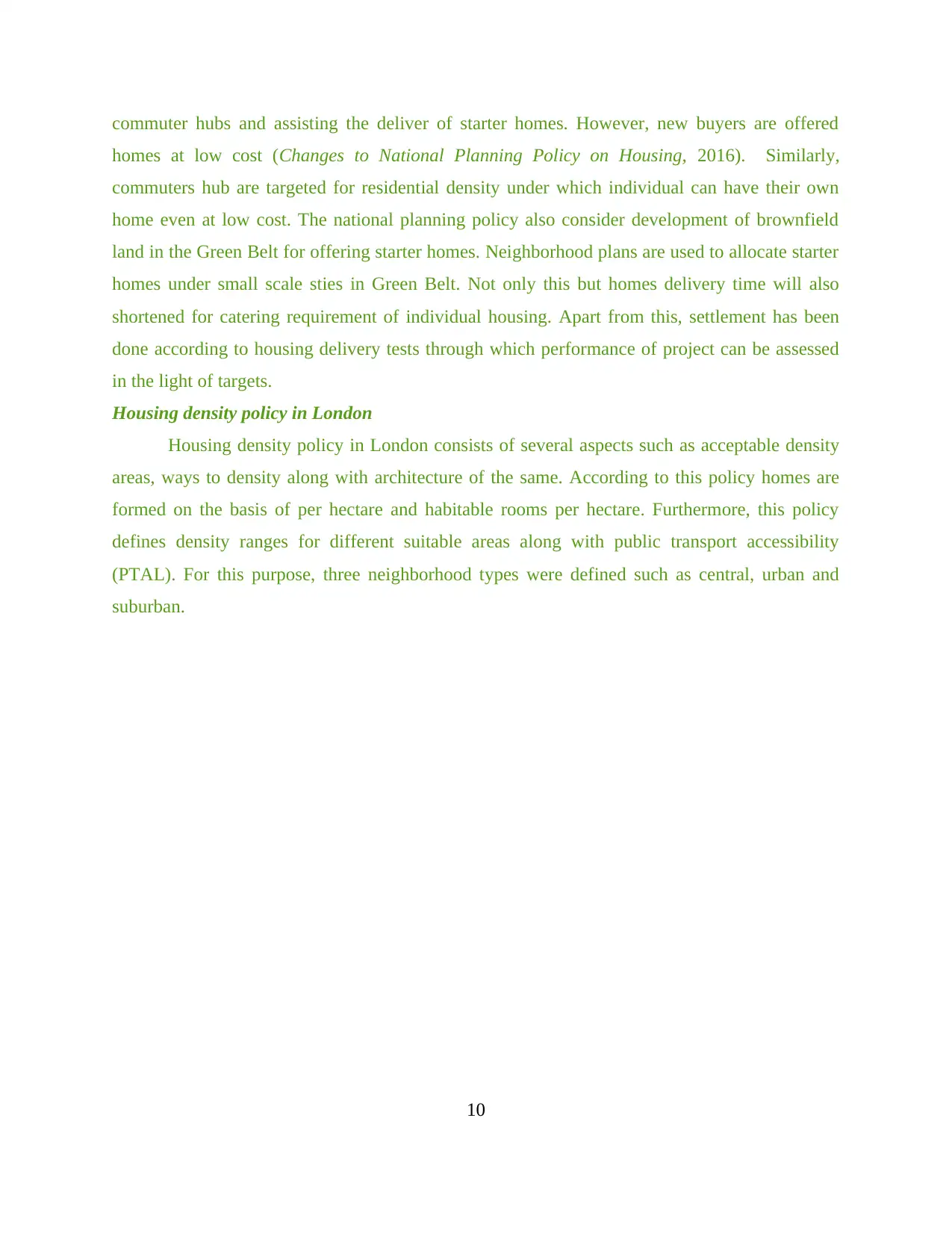
commuter hubs and assisting the deliver of starter homes. However, new buyers are offered
homes at low cost (Changes to National Planning Policy on Housing, 2016). Similarly,
commuters hub are targeted for residential density under which individual can have their own
home even at low cost. The national planning policy also consider development of brownfield
land in the Green Belt for offering starter homes. Neighborhood plans are used to allocate starter
homes under small scale sties in Green Belt. Not only this but homes delivery time will also
shortened for catering requirement of individual housing. Apart from this, settlement has been
done according to housing delivery tests through which performance of project can be assessed
in the light of targets.
Housing density policy in London
Housing density policy in London consists of several aspects such as acceptable density
areas, ways to density along with architecture of the same. According to this policy homes are
formed on the basis of per hectare and habitable rooms per hectare. Furthermore, this policy
defines density ranges for different suitable areas along with public transport accessibility
(PTAL). For this purpose, three neighborhood types were defined such as central, urban and
suburban.
10
homes at low cost (Changes to National Planning Policy on Housing, 2016). Similarly,
commuters hub are targeted for residential density under which individual can have their own
home even at low cost. The national planning policy also consider development of brownfield
land in the Green Belt for offering starter homes. Neighborhood plans are used to allocate starter
homes under small scale sties in Green Belt. Not only this but homes delivery time will also
shortened for catering requirement of individual housing. Apart from this, settlement has been
done according to housing delivery tests through which performance of project can be assessed
in the light of targets.
Housing density policy in London
Housing density policy in London consists of several aspects such as acceptable density
areas, ways to density along with architecture of the same. According to this policy homes are
formed on the basis of per hectare and habitable rooms per hectare. Furthermore, this policy
defines density ranges for different suitable areas along with public transport accessibility
(PTAL). For this purpose, three neighborhood types were defined such as central, urban and
suburban.
10
Paraphrase This Document
Need a fresh take? Get an instant paraphrase of this document with our AI Paraphraser
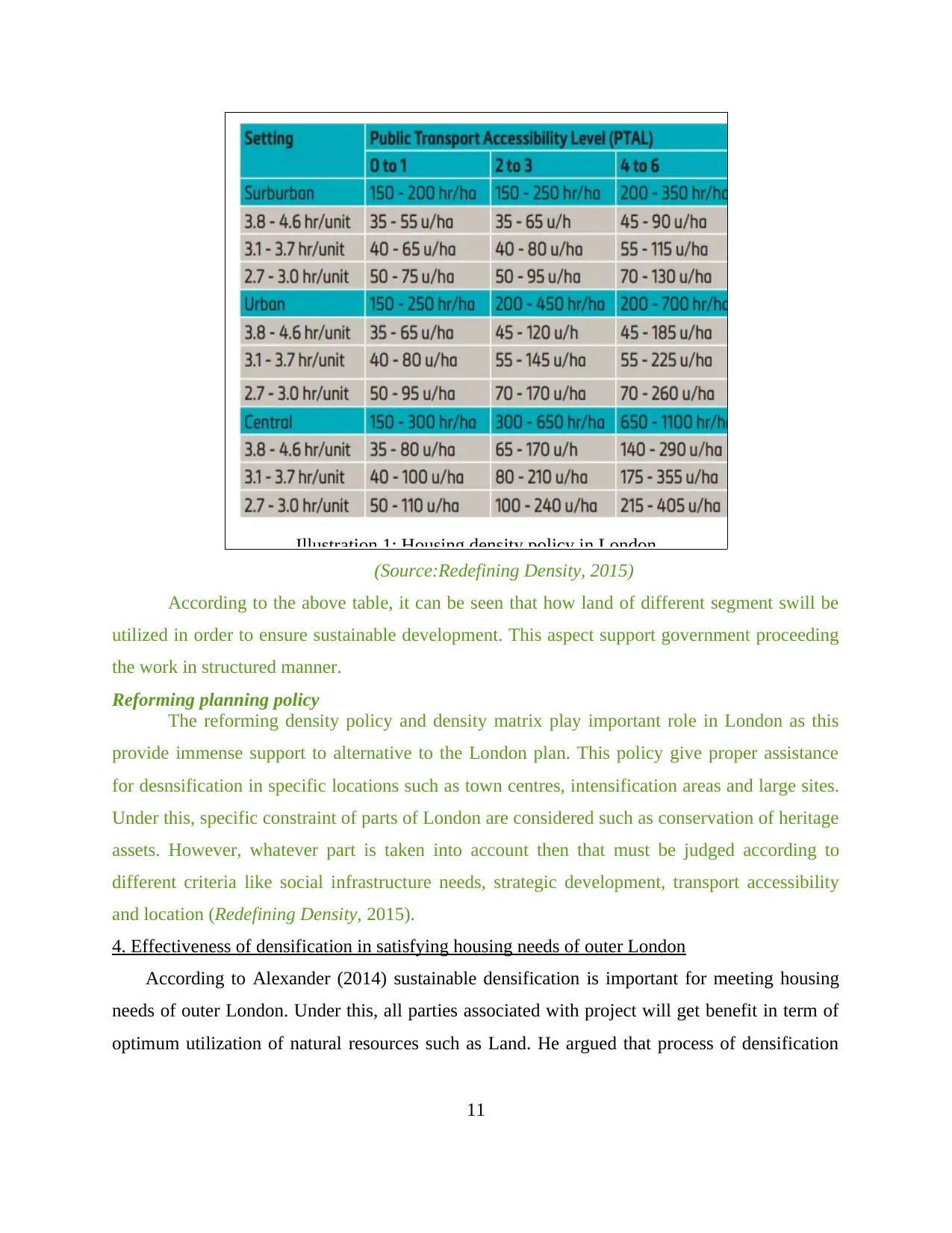
(Source:Redefining Density, 2015)
According to the above table, it can be seen that how land of different segment swill be
utilized in order to ensure sustainable development. This aspect support government proceeding
the work in structured manner.
Reforming planning policy
The reforming density policy and density matrix play important role in London as this
provide immense support to alternative to the London plan. This policy give proper assistance
for desnsification in specific locations such as town centres, intensification areas and large sites.
Under this, specific constraint of parts of London are considered such as conservation of heritage
assets. However, whatever part is taken into account then that must be judged according to
different criteria like social infrastructure needs, strategic development, transport accessibility
and location (Redefining Density, 2015).
4. Effectiveness of densification in satisfying housing needs of outer London
According to Alexander (2014) sustainable densification is important for meeting housing
needs of outer London. Under this, all parties associated with project will get benefit in term of
optimum utilization of natural resources such as Land. He argued that process of densification
11
Illustration 1: Housing density policy in London
According to the above table, it can be seen that how land of different segment swill be
utilized in order to ensure sustainable development. This aspect support government proceeding
the work in structured manner.
Reforming planning policy
The reforming density policy and density matrix play important role in London as this
provide immense support to alternative to the London plan. This policy give proper assistance
for desnsification in specific locations such as town centres, intensification areas and large sites.
Under this, specific constraint of parts of London are considered such as conservation of heritage
assets. However, whatever part is taken into account then that must be judged according to
different criteria like social infrastructure needs, strategic development, transport accessibility
and location (Redefining Density, 2015).
4. Effectiveness of densification in satisfying housing needs of outer London
According to Alexander (2014) sustainable densification is important for meeting housing
needs of outer London. Under this, all parties associated with project will get benefit in term of
optimum utilization of natural resources such as Land. He argued that process of densification
11
Illustration 1: Housing density policy in London
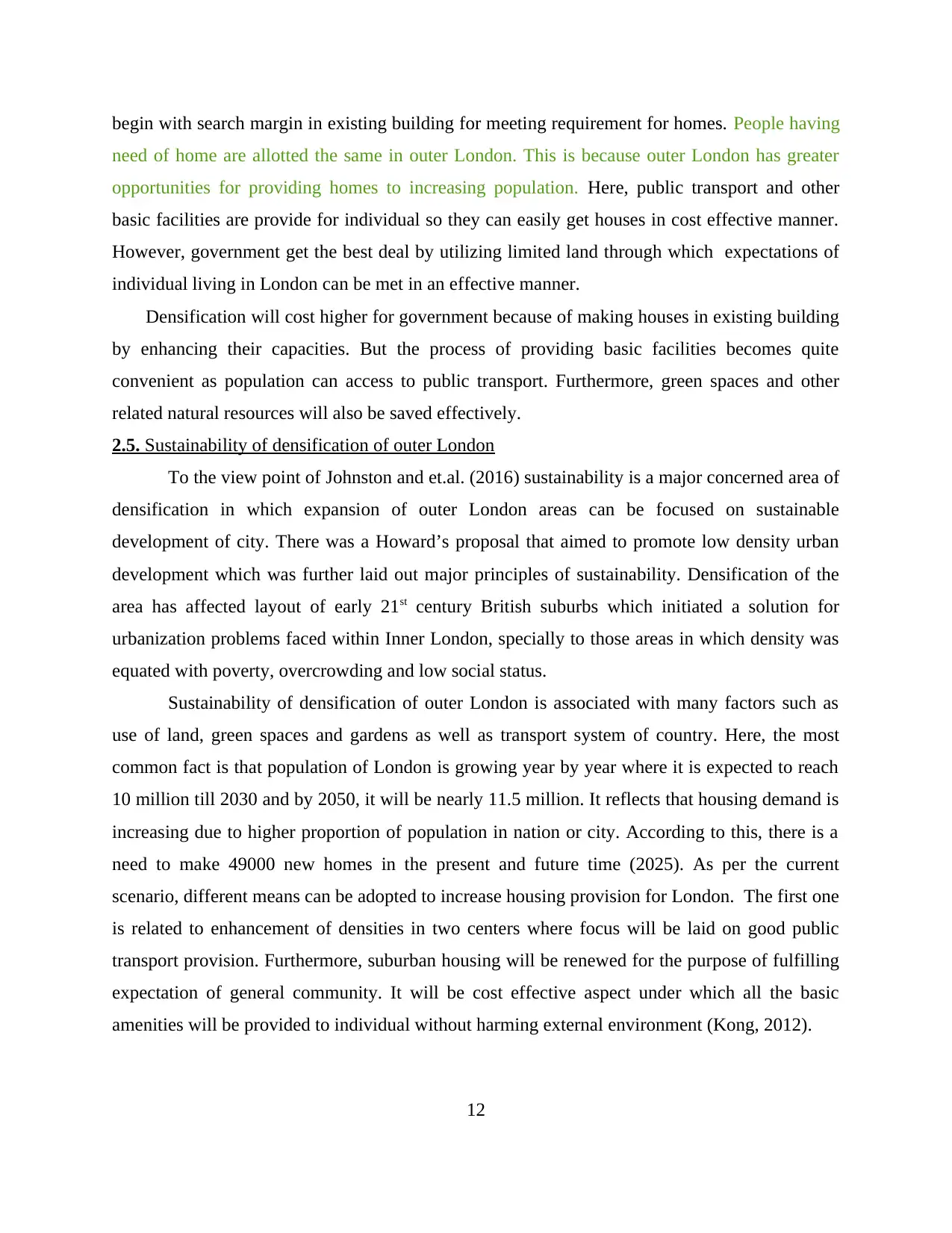
begin with search margin in existing building for meeting requirement for homes. People having
need of home are allotted the same in outer London. This is because outer London has greater
opportunities for providing homes to increasing population. Here, public transport and other
basic facilities are provide for individual so they can easily get houses in cost effective manner.
However, government get the best deal by utilizing limited land through which expectations of
individual living in London can be met in an effective manner.
Densification will cost higher for government because of making houses in existing building
by enhancing their capacities. But the process of providing basic facilities becomes quite
convenient as population can access to public transport. Furthermore, green spaces and other
related natural resources will also be saved effectively.
2.5. Sustainability of densification of outer London
To the view point of Johnston and et.al. (2016) sustainability is a major concerned area of
densification in which expansion of outer London areas can be focused on sustainable
development of city. There was a Howard’s proposal that aimed to promote low density urban
development which was further laid out major principles of sustainability. Densification of the
area has affected layout of early 21st century British suburbs which initiated a solution for
urbanization problems faced within Inner London, specially to those areas in which density was
equated with poverty, overcrowding and low social status.
Sustainability of densification of outer London is associated with many factors such as
use of land, green spaces and gardens as well as transport system of country. Here, the most
common fact is that population of London is growing year by year where it is expected to reach
10 million till 2030 and by 2050, it will be nearly 11.5 million. It reflects that housing demand is
increasing due to higher proportion of population in nation or city. According to this, there is a
need to make 49000 new homes in the present and future time (2025). As per the current
scenario, different means can be adopted to increase housing provision for London. The first one
is related to enhancement of densities in two centers where focus will be laid on good public
transport provision. Furthermore, suburban housing will be renewed for the purpose of fulfilling
expectation of general community. It will be cost effective aspect under which all the basic
amenities will be provided to individual without harming external environment (Kong, 2012).
12
need of home are allotted the same in outer London. This is because outer London has greater
opportunities for providing homes to increasing population. Here, public transport and other
basic facilities are provide for individual so they can easily get houses in cost effective manner.
However, government get the best deal by utilizing limited land through which expectations of
individual living in London can be met in an effective manner.
Densification will cost higher for government because of making houses in existing building
by enhancing their capacities. But the process of providing basic facilities becomes quite
convenient as population can access to public transport. Furthermore, green spaces and other
related natural resources will also be saved effectively.
2.5. Sustainability of densification of outer London
To the view point of Johnston and et.al. (2016) sustainability is a major concerned area of
densification in which expansion of outer London areas can be focused on sustainable
development of city. There was a Howard’s proposal that aimed to promote low density urban
development which was further laid out major principles of sustainability. Densification of the
area has affected layout of early 21st century British suburbs which initiated a solution for
urbanization problems faced within Inner London, specially to those areas in which density was
equated with poverty, overcrowding and low social status.
Sustainability of densification of outer London is associated with many factors such as
use of land, green spaces and gardens as well as transport system of country. Here, the most
common fact is that population of London is growing year by year where it is expected to reach
10 million till 2030 and by 2050, it will be nearly 11.5 million. It reflects that housing demand is
increasing due to higher proportion of population in nation or city. According to this, there is a
need to make 49000 new homes in the present and future time (2025). As per the current
scenario, different means can be adopted to increase housing provision for London. The first one
is related to enhancement of densities in two centers where focus will be laid on good public
transport provision. Furthermore, suburban housing will be renewed for the purpose of fulfilling
expectation of general community. It will be cost effective aspect under which all the basic
amenities will be provided to individual without harming external environment (Kong, 2012).
12
⊘ This is a preview!⊘
Do you want full access?
Subscribe today to unlock all pages.

Trusted by 1+ million students worldwide
1 out of 24
Related Documents
Your All-in-One AI-Powered Toolkit for Academic Success.
+13062052269
info@desklib.com
Available 24*7 on WhatsApp / Email
![[object Object]](/_next/static/media/star-bottom.7253800d.svg)
Unlock your academic potential
Copyright © 2020–2025 A2Z Services. All Rights Reserved. Developed and managed by ZUCOL.





